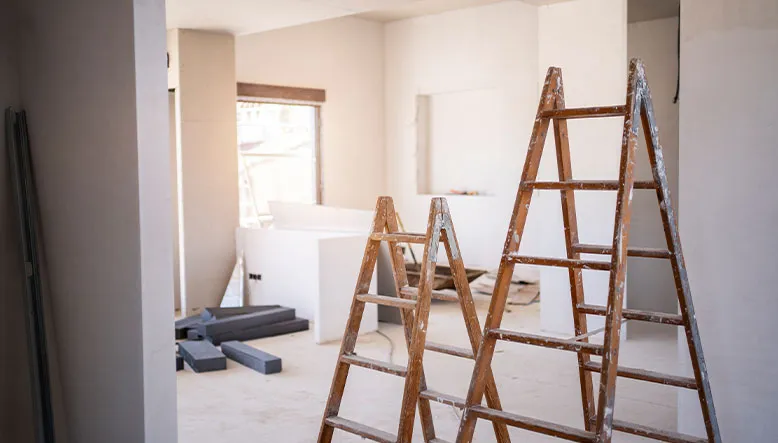When thinking about renovating a home, one of the first decisions you should make is to choose the type of renovation that best suits your needs, budget and lifestyle. The most common options are a comprehensive renovation, which encompasses a complete transformation of the house, or a small renovation, which focuses on specific areas. Each option has its advantages and challenges, and the choice will depend on your goals and resources. Below, we will help you understand the differences, advantages and disadvantages of each, so you can make an informed and wise decision.
What is involved in a complete renovation and a small renovation?
To decide between a complete renovation and a small renovation, it is essential to know the characteristics of each type of project.
Complete renovation
A comprehensive reform is a complete renovation of the property, which may include the redistribution of spaces, updating facilities, floors, walls and finishes throughout the house. This type of reform allows redesigning each area to suit the taste and needs of the owner. It is ideal when a deep transformation of the space and its functionality is sought, and when the property is many years old or shows significant wear and tear.

Small renovation
A partial or small renovation focuses on specific areas of the home, such as a kitchen, bathroom or living room renovation, or on aesthetic and functional changes without intervening the entire house. These renovations are ideal when you are looking for a specific improvement or want to change the aesthetics of some spaces without undertaking a major project. This type of intervention also allows you to adjust the budget without affecting other areas of the house.
Each type of renovation responds to different needs and budgets, so it is important to evaluate which one is best suited to your situation.
Advantages and disadvantages of a complete renovation
A comprehensive reform offers numerous benefits, but it also involves some challenges. Here are the main advantages and disadvantages:
Advantages of a complete renovation
- Total transformation: Allows the space to be completely redesigned and optimized, adapting it to the lifestyle and preferences of the owners. This transformation can include from changes in the distribution to the choice of materials and finishes to achieve a modern and functional aesthetic.
- Updating installations: A comprehensive reform provides the opportunity to renew electrical, plumbing and air conditioning installations, improving energy efficiency and increasing the safety of the home. This is a particularly relevant factor in older homes.
- Aesthetic consistency and increased value: By doing a complete renovation, you can create a uniform, quality look throughout the home, which not only improves the overall appearance, but also increases the value of the property, something to consider if you plan to sell in the future.
Disadvantages of a complete renovation
- High cost: As a complete renovation, the costs are considerably higher than in a partial renovation. However, in the long run, a complete renovation can avoid future expenses in maintenance or repairs.
- Project duration and relocation: Comprehensive renovations usually require more time to complete, and in many cases, it will be necessary for you to temporarily relocate. This can be inconvenient for daily life and family planning.
Advantages and disadvantages of a small renovation
Partial renovation, although smaller in scope, has advantages that make it an attractive option for those seeking to improve specific aspects of their home.
Advantages of a small renovation
- Lower investment and budget control: Because it focuses on specific areas, this type of reform allows for greater budget control and significantly reduces costs compared to a comprehensive reform.
- Speed and ease: Partial reforms require less time and, in most cases, it is not necessary to move house, since the works do not affect the whole house. This makes it easier to carry out the work without disrupting daily life.
- Functional or aesthetic adaptation: Allows for specific changes in key areas, such as the bathroom or kitchen, without the need to renovate the entire house. It is ideal for those who wish to aesthetically update some spaces without a major project.

Disadvantages of a small renovation
- Limited impact and future costs: While partial renovations are quick and effective, they do not always solve structural or substantive problems, which may generate additional costs in the future if the problems are not fully addressed.
- Aesthetic consistency difficulties: Renovating only certain areas of the house can create visual disharmony if the rest of the house is left intact. This can be a problem when the renovation is visible from other non-renovated areas.
When to opt for a complete renovation or a small renovation?
To make the decision between a full renovation and a small renovation, consider the following key factors:
Budget and time
Complete renovations require a greater investment and time, while a partial renovation is more suitable for tighter budgets and timescales.
Condition of the property
If the house has infrastructure problems, wear and tear in electrical or plumbing installations, a complete renovation is the ideal option to ensure safety and durability. For specific or aesthetic improvements, partial renovation may be sufficient.
Reform objectives
If you are looking for a total and long-term transformation, a full renovation is the best option. On the other hand, a partial renovation is ideal for updating only a few areas, such as a bathroom or kitchen, or improving the functionality of a specific room.
Complexity of the project
Comprehensive renovations usually require more extensive planning, especially if they involve structural changes. Partial renovations, although less complex, also require organization, especially to avoid design consistency problems.
Choosing between a complete renovation and a partial renovation depends on the condition of the house, the budget and your short and long term goals. At ParaTuReforma, backed by the experience of Grupo Unamacor S.L., we have a team of experts to offer you personalized advice and support in any of these options. With our professional approach and experience in projects of all kinds, we will help you maximize your investment and achieve a result that fits your needs.
How long can a complete renovation take?
The time for a complete renovation varies according to the complexity and size of the house, but generally it can last from several weeks to several months. It is advisable to plan the project in advance and have a schedule to organize the stages of the renovation.
Can I stay at home during a partial renovation?
In most cases, yes. Small renovations are usually less invasive and allow homeowners to remain in the home during the work. However, it will depend on the type of renovation and the area in which the work is being done.
Is it more expensive to carry out several partial renovations or a complete renovation?
It will depend on the areas you want to renovate and the magnitude of the changes. Doing several partial renovations over time may be more expensive than doing a comprehensive renovation all at once, especially if the goal is a complete change in the home’s design and fixtures.


